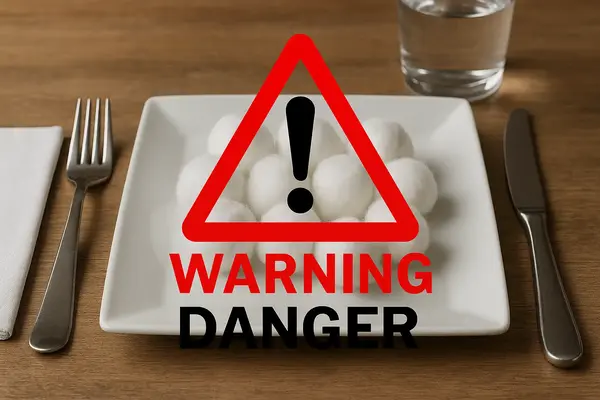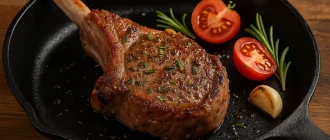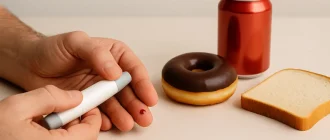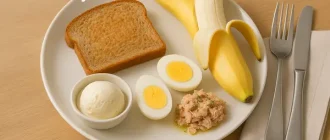The Cotton Ball Diet is a highly dangerous practice where people swallow cotton balls to feel full without eating real food. It’s like trying to trick your body by stuffing it with empty space — the stomach may seem filled, but the damage begins inside. Even one cotton ball can block the intestines or cause choking, turning a single “experiment” into a medical emergency.
Sometimes called the cotton ball cleanse or cotton fullness method, this trend spreads through social media as a quick weight-loss hack. But it’s closer to swallowing pieces of fabric than following a diet — the body can’t digest synthetic fibers, and they can clump together like wet paper in a drain. Health experts report severe cases of bowel obstruction, internal infection, and lasting nutritional deficiencies even after limited use.
When someone thinks of trying such a method, believing it’s safer than eating less, the reality is far from it. Replacing food with cotton, much like filling an engine with fluff instead of fuel, only leads to system failure. Understanding that even one cotton ball poses serious danger is key to rejecting this toxic and deceptive weight-loss myth.
What Is the Cotton Ball Diet?
The Cotton Ball Diet involves eating cotton balls soaked in juice or another liquid to curb hunger and keep caloric intake low. Proponents claim that the cotton balls fill your stomach, making you feel full without ingesting many calories. Sounds like an easy fix, right? Not quite.
Is It Really Cotton?
A lot of people assume that cotton balls are made from pure, natural cotton. In reality, most cotton balls sold in stores are actually made from synthetic fibers like polyester. Consuming them isn’t just a matter of eating some “fluffy natural fibers”; it’s more akin to swallowing plastic.
The Immediate Dangers
One of the most immediate and life-threatening risks of eating cotton balls is intestinal obstruction, a condition known as a bezoar. Bezoars form when indigestible substances accumulate in the stomach or intestines, blocking normal digestive processes. This could lead to extreme pain, vomiting, and in severe cases, a complete blockage that requires surgical removal.
Did You Know?
Bezoars have been documented as a major cause of gastrointestinal obstruction, particularly in young people trying dangerous diet trends (Mayo Clinic).
Choking Hazards and Malnutrition
Another clear risk is choking. Cotton balls are not easy to swallow, and they can easily get stuck in the throat, leading to choking. Additionally, since cotton provides no nutritional value, people who follow this diet often face malnutrition. Essential vitamins, minerals, proteins, and fats are all lacking, which leads to long-term health consequences like weakened immune function, hair loss, and chronic fatigue.
Could It Kill You?
Yes, the Cotton Ball Diet can kill you. If an intestinal blockage isn’t treated quickly, it can lead to sepsis, a life-threatening condition where the body releases chemicals into the bloodstream to fight infection. The response to these chemicals can trigger widespread inflammation, potentially leading to organ failure.
Modern Trend, Ancient Problem
The idea of consuming non-food items is not new. A condition known as pica involves the compulsion to eat substances that are not typically considered food, like dirt, chalk, or even metal. The Cotton Ball Diet might be a modern twist on this ancient problem, but it’s no less dangerous. Health professionals have strongly condemned it, with nutritionists pointing out the alarming consequences.
The Cost of Misguided Diets
While the Cotton Ball Diet might be seen as a low-cost solution to weight loss, the potential costs of emergency surgery or long-term health damage are far from cheap. In 2023, a case study published in the Journal of Emergency Medicine detailed the surgical removal of a bezoar in a 19-year-old who had followed the Cotton Ball Diet. The cost of her medical care exceeded $20,000—not exactly the savings you’d hope for from a budget-friendly diet.
Social Media’s Role
The spread of this diet can be largely attributed to social media, where influencers often flaunt dangerous weight-loss practices without fully understanding (or sharing) the consequences. Many young people are especially susceptible to such trends, looking for quick fixes to complex problems.
Did You Know?
A survey by the American Psychological Association in 2022 found that 37% of teenagers felt pressured by social media to follow potentially harmful weight-loss trends (APA).
What Should You Do Instead?
Instead of risking your health with drastic and dangerous measures, consider balanced, scientifically-supported methods for weight loss. A diet rich in vegetables, fruits, lean proteins, and whole grains, combined with regular exercise, has been shown time and again to be the most effective and sustainable method.
If you’re struggling with body image issues, it may also be helpful to talk to a mental health professional. Many dangerous diet practices stem from emotional struggles, and addressing the root cause can be a far healthier way forward.
Editor’s Advice
The Cotton Ball Diet is not just ineffective; it is life-threatening. No weight-loss journey is worth risking your health or life. There are no shortcuts—and even if there were, they wouldn’t be made of synthetic fluff. Make informed decisions, seek professional guidance, and remember that true health is more than just the number on a scale.
About the Author
Reyus Mammadli is the author of this health blog since 2008. With a background in medical and biotechnical devices, he has over 15 years of experience working with medical literature and expert guidelines from WHO, CDC, Mayo Clinic, and others. His goal is to present clear, accurate health information for everyday readers — not as a substitute for medical advice.







